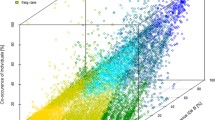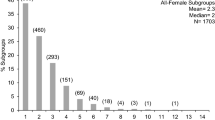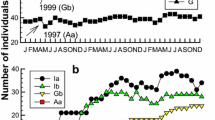Abstract
Knowledge of the processes of group formation is important to understand the evolution of animal societies. Ungulates typically aggregate during the breeding season. According to the self-organization theory, proximal processes such as mating tactics should explain variation in average group size through their influences on group dynamics. Here, we tested whether variation of the fusion rate or fission rate led to an increase of average group size at the beginning of the peak rut. We followed the movement of marked animals within an enclosed herd of reindeer Rangifer tarandus during two breeding seasons (2009 and 2011). We used synchronized GPS collars that fixed the animals’ position every hour (2009) and every 15 min (2011). Group dynamics occurred in three steps as follows: (1) a continuous aggregation of groups, (2) a continuous departure of single females from these groups, and (3) the aggregation of these solitary females to form new groups. We attributed the increase in average group size mainly to a decrease in the number of groups due to a decrease in the group and individual splitting propensities, rather than to an increase of their merging propensities. A decrease in the splitting propensity at the beginning of the peak rut may be due to males herding females, female mate choice, or female harassment avoidance. Further research on fission-fusion group dynamics should calculate merging and splitting propensities by controlling for variables such as group size, group density, or habitat characteristics.





Similar content being viewed by others
References
Aung M, Mcshea WJ, Htung S, Than A, Soe TM, Wemmer C (2001) Ecology and social organization of a tropical deer (Cervus eldi thamin). Am Soc Mammal 82:836–847
Aureli F, Schaffner CM, Boesch C, Bearder SK, Call J, Chapman CA, Connor R, Di Fiore A, Dunbar RIM, Henzi SP, Holekamp KE, Korstjens AH, Layton R, Lee PC, Lehmann J, Manson JH, Ramos-Fernández G, Strier KB, van Schaik CP (2008) Fission-fusion dynamics: new research frameworks. Curr Anthropol 49:627–654
Aureli F, Schaffner CM, Asensio N, Lusseau D (2012) What is a subgroup? How socioecological factors influence interindividual distance. Behav Ecol 23:1308–1315
Baddeley A (2010) Analysing spatial point patterns in R. :version 4.1 http://www.csiro.au/files/files/piph.pdf
Baddeley A, Gill RD (1997) Kaplan-Meier estimators of distance distributions for spatial point processes. Ann Stat 25:263–292
Barrette C (1991) The size of axis deer fluid groups in Wilpattu national park, Sri Lanka. Mammalia 55:207–220
Beauchamp G (2011) Functional relationship between group size and population density in Northwest Atlantic seabirds. Mar Ecol Prog Ser 435:225–233
Bercovitch FB, Berry PSM (2010) Ecological determinants of herd size in the Thornicroft’s giraffe of Zambia. Afr J Ecol 48:962–971
Bercovitch FB, Berry PSM (2012) Herd composition, kinship and fission-fusion social dynamics among wild giraffe. Afr J Ecol 51:206–216
Borkowski JJ, Furubayashi K (1998) Seasonal and diel variation in group size among Japanese sika deer in different habitats. J Zool (Lond) 245:29–34
Bro-Jørgensen J (2011) Intra- and intersexual conflicts and cooperation in the evolution of mating strategies: lessons learnt from ungulates. Evol Biol 38:28–41
Byers JA, Moodie JD, Hall N (1994) Pronghorn females choose vigorous mates. Anim Behav 47:33–43
Carter AJ, Pays O, Goldizen AW (2009) Individual variation in the relationship between vigilance and group size in eastern grey kangaroos. Behav Ecol Sociobiol 64:237–245
Caughley G (1964) Social organization and daily activity of the red kangaroo and the grey kangaroo. Am Soc Mammal 45:429–436
Clutton-Brock TH, McAuliffe K (2009) Female mate choice in mammals. Q Rev Biol 84:3–27
Clutton-Brock TH, Guinness F, Albon SD (1982) Red deer. Behavior and ecology of two sexes. Edinburgh University Press, Edinburgh
Clutton-Brock TH, Price OF, MacColl ADC (1992) Mate retention, harassment, and the evolution of ungulate leks. Behav Ecol 3:234–242
Couzin ID (2006) Behavioral ecology: social organization in fission-fusion societies. Curr Biol 16:169–171
Couzin ID, Krause J (2003) Self-organization and collective behavior in vertebrates. Adv Study Behav 32:1–75
Couzin ID, Laidre ME (2009) Fission-fusion populations. Curr Biol 19:633–635
Crawley MJ (2007) The R book. John Wiley & Sons Ltd., Chichester, UK
Croft DP, James R, Krause J (2008) Exploring animal social networks. Princeton University Press, Princeton
Danchin E, Giraldeau L-A, Cézilly F (2008) Behavioural ecology. Oxford University Press, Oxford
de Jong K, Forsgren E, Sandvik H, Amundsen T (2012) Measuring mating competition correctly: available evidence supports operational sex ratio theory. Behav Ecol 23:1170–1177
Djaković N, Holand Ø, Hovland AL, Røed KH, Weladji RB, Fjeldstad E, Nieminen M (2012) Association patterns and kinship in female reindeer (Rangifer tarandus) during rut. Acta Ethol 15:165–171
Emlen ST, Oring LW (1977) Ecology, sexual selection, and the evolution of mating systems. Science 197:215–223
Fishlock V, Lee PC (2013) Forest elephants: fission–fusion and social arenas. Anim Behav 85:357–363
Focardi S, Pecchioli E (2005) Social cohesion and foraging decrease with group size in fallow deer (Dama dama). Behav Ecol Sociobiol 59:84–91
Fortin D, Fortin M-E, Beyer HL, Duchesne T, Courant S, Dancose K (2009) Group-size-mediated habitat selection and group fusion-fission dynamics of bison under predation risk. Ecology 90:2480–2490
Gerard J-F, Bideau E, Maublanc M-L, Loisel P, Marchal C (2002) Herd size in large herbivores: encoded in the individual or emergent? Biol Bull 202:275–282
Gower CN, Garrott RA, White PJ, Cherry S, Yoccoz NG (2009) Elk group size and wolf predation: a flexible strategy when faced with variable risk. In: Garrott RA, White PJ, Watson FGR (eds) The ecology of large mammals in central Yellowstone, sixteen years of integrated field studies. Terrestria. Academic Press, New York, p 401:422
Haydon DT, Morales JM, Yott A, Jenkins DA, Rosatte R, Fryxell JM (2008) Socially informed random walks: incorporating group dynamics into models of population spread and growth. Proc R Soc Lond 275:1101–1109
Jarman P (1974) The social organisation of antelope in relation to their ecology. Behaviour 48:215–267
Jedrzejewski W, Spaedtke H, Kamler JF, Jedrzejewska B, Stenkewitz U (2006) Group size dynamics of red deer in Białowieza Primeval Forest, Poland. J Wildl Manag 70:1054–1059
Johnson CN (1983) Variations in group size and composition in red and western grey kangaroos, Macropus rufus (Desmarest) and M. fuliginosus (Desmarest). Aust Wildl Res 10:25–31
Juanico DEO (2009) Herding tendency as an aggregating factor in a binary mixture of social entities. Ecol Model 220:3521–3526
King AJ, Wilson AM, Wilshin SD, Lowe JC, Haddadi H, Hailes S, Morton AJ (2012) Selfish-herd behaviour of sheep under threat. Curr Biol 22:561–562
Kojola I (1986) Rutting behaviour in an enclosured group of wild forest reindeer. Rangifer 1:173–179
Krause J, Krause S, Arlinghaus R, Psorakis I, Roberts S, Rutz C (2013) Reality mining of animal social systems. Trends Ecol Evol 28:541–551
L’Italien L, Weladji RB, Holand Ø, Røed KH, Nieminen M, Côté SD (2012) Mating group size and stability in reindeer Rangifer tarandus: the effects of male characteristics, sex ratio and male age structure. Ethology 118:783–792
Marshall HH, Carter AJ, Rowcliffe JM, Cowlishaw G (2012) Linking social foraging behaviour with individual time budgets and emergent group-level phenomena. Anim Behav 84:1295–1305
Mysterud A, Røed KH, Holand Ø, Yoccoz NG, Nieminen M (2009) Age-related gestation length adjustment in a large iteroparous mammal at northern latitude. J Anim Ecol 78:1002–1006
Pays O, Benhamou S, Helder R, Gerard J-F (2007) The dynamics of group formation in large mammalian herbivores: an analysis in the European roe deer. Anim Behav 74:1429–1441
Pays O, Fortin D, Gassani J, Duchesne J (2012) Group dynamics and landscape features constrain the exploration of herds in fusion-fission societies: the case of European roe deer. PLoS ONE 7:e34678
Pépin D, Gerard J-F (2008) Group dynamics and local population density dependence of group size in the Pyrenean chamois, Rupicapra pyrenaica. Anim Behav 75:361–369
Proffitt KM, Gude JA, Shamhart J, King F (2012) Variations in elk aggregation patterns across a range of elk population sizes at Wall Creek, Montana. J Wildl Manag 76:847–856
Reimers E, Røed KH, Colman JE (2012) Persistence of vigilance and flight response behaviour in wild reindeer with varying domestic ancestry. J Evol Biol 25:1543–1554
Ripley BD (1988) Statistical inference for spatial processes. Cambridge University Press, New York
Sueur C, King AJ, Conradt L, Kerth G, Lusseau D, Mettke-Hofmann C, Schaffner CM, Williams L, Zinner D, Aureli F (2011) Collective decision-making and fission-fusion dynamics: a conceptual framework. Oikos 120:1608–1617
Tennenhouse EM, Weladji RB, Holand Ø, Røed KH, Nieminen M (2011) Mating group composition influences somatic costs and activity in rutting dominant male reindeer (Rangifer tarandus). Behav Ecol Sociobiol 65:287–295
Tennenhouse EM, Weladji RB, Holand Ø, Nieminen M (2012) Timing of reproductive effort differs between young and old dominant male reindeer. Ann Zool Fennici 49:152–160
Wade MJ, Shuster SM (2004) Sexual selection: harem size and the variance in male reproductive success. Am Nat 164:E83–E89
White PJ, Gower CN, Davis TL, Sheldon JW, White JR (2012a) Group dynamics of Yellowstone pronghorn. J Mammal 93:1129–1138
White PJ, Proffitt KM, Lemke TO (2012b) Changes in elk distribution and group sizes after wolf restoration. Am Midl Nat 167:174–187
Wiley RH, Poston J (1996) Indirect mate choice, competition for mates, and coevolution of the sexes. Evolution 50:1371–1381
Acknowledgments
The authors thank Jukka Siitari of the Finnish Game and Fisheries Research Station for the management of GPS collars data, and Mika Tervonen of the Finnish Reindeer Herder’s Association for the management of reindeers in Finland. We thank Sacha Engelhardt, Natalka Melnycky, and Hallvard Gjøstein who helped with data collection and Guillaume Larocque from the Quebec Center for Biodiversity Sciences for help with the statistics. We thank two anonymous reviewers for their helpful comments on an earlier version of this manuscript. We also acknowledge the financial support of the Natural Sciences and Engineering Research Council of Canada (RBW) and the Research Council of Norway (ØH).
Author information
Authors and Affiliations
Corresponding author
Electronic supplementary material
Below is the link to the electronic supplementary material.
ESM 1
(DOCX 253 kb)
(AVI 14790 kb)
(AVI 13098 kb)
Rights and permissions
About this article
Cite this article
Body, G., Weladji, R.B., Holand, Ø. et al. Fission-fusion group dynamics in reindeer reveal an increase of cohesiveness at the beginning of the peak rut. acta ethol 18, 101–110 (2015). https://doi.org/10.1007/s10211-014-0190-8
Received:
Revised:
Accepted:
Published:
Issue Date:
DOI: https://doi.org/10.1007/s10211-014-0190-8




